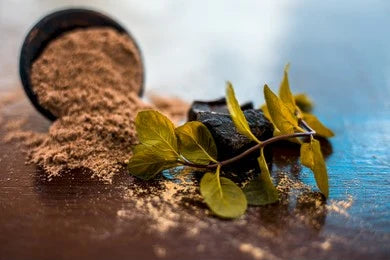A member of the apiaceae family, ferula is a perennial herbaceous monoecious plant. This plant can reach a height of 2 meters, with its 30- to 40-cm-diameter circular leaf mass. This herb has very delicate leaves and golden blooms. All portions of the plant smell strongly of fetid matter and have a disagreeable taste. The plant's stalk is cut close to the roots just before flowering, and from these cuts, a milky fluid flows out and eventually hardens into resin. Three months after the initial incision, the treatment is complete. The plant produces more than two pounds of resin during this period. Fruits are reddish brown in hue and flat, thin, oval in shape. The self-fertilizing asafetida plant possesses both male and female blooms that are pollinated by insects.
General Information
The common name for this herb is asafetida; the Latin word "foetid" means "very odorous." It is a bitter, pungent herb with a repulsive smell. Common names for this herb include Food of the God, asant, smelling gum, devil's dung, hing, hingu, ting, and kayam. Cutting the living rhizome and tap roots of the several species of ferula causes hing, a resinous, gum-like substance, to flow. Asafetida has a fetid smell and a bitter flavor, as its name would imply. Hing is used in Ayurveda for its several medicinal benefits. This plant is best used as a digestive aid and as a cooking spice. This herb is used in the kitchen to make pickles and curries. In its purest state, it has a powerful scent.
The two main types of hing that are readily available are hing kabuli saffed (milky white hing) and lal hing (red hing). While the milky white version of hing is easily soluble in water, the red variety is oil soluble. Since it can be used in processed powder and tablet form, the pure form of hingu is not favored.
It was considered the food of the gods and was a common dish in ancient Rome.
Habitat
Asafetida is a plant that is primarily native to Iran, Pakistan, and Afghanistan. It is exported all over the world. It is frequently growing in Kashmir, India.
Classification
Kingdom - Plantae
Family - Apiaceae
Order - Apiales
Other Names
English name - Devil's dung, Food of god
Hindi name - Heeng, Hing
Telugu name - Inguva
Bengali name - Hing
Kannada name - Hingu
Marathi name - Hing
Gujarati name - Badharani
Tamil name - Perungayam
Malayalam name - Rungayam
Farsi name - Angajah, Angoj
Arabic name - Hilteel
French name - Assa foetida, Ferulr perisque
German name - Asafotida, Stinkender asant
Italian name - Assafetida
Spanish name - Asafetida
Afghan name - Kama-i-anguza
Turkish name - Seyan tersi
Ayurvedic Properties
|
|
Hindi / Sanskrit |
English |
|
Rasa (Taste) |
Katu |
Pungent |
|
Guna (Action) |
Laghu, Snigdha, Teekshana |
Light, Unctuous, Sharp |
|
Virya (Potency) |
Ushna |
Hot |
|
Vipaka (Post-Digestive Taste) |
Katu |
Pungent |
Effects on Doshas
It balances kapha and vata dosha.
|
Charak Samhita |
Sushrut Samhita |
Vagbhata |
|
|
|
Practical uses
- It is a wonderful spice for treating digestive problems. It has antispasmodic properties and is used to treat worm infestation, irritable bowel syndrome, flatulence, and abdominal pain.
- Asthma, cough, the common cold, whooping cough, and numerous respiratory problems are just a few of the conditions it is used to treat because it has anti-inflammatory, antiviral, and antibacterial properties. It helps to clear the body of excess phlegm and chest congestion while acting as a stimulant for the respiratory system.
- It is a blessing for women's health and aids in reducing period pain as well as heavy and irregular menstrual flow. It facilitates a smooth menstrual blood flow and is used to increase progesterone hormone levels.
- The hectic schedules of today make headaches and migraines a fairly prevalent ailment. In addition to being used to treat headaches, hingu is used to lessen blood vessel irritation.
- Asafetida is used to induce abortions since it contains abortifacient qualities as well.
- Additionally, it serves as an opium antidote.
- Coumarins, which are used to lessen blood clotting, are abundant in hing. This plant has an anti-coagulant property that aids the body in fighting against high cholesterol levels and is highly effective in lowering high blood pressure.
- It serves to activate the nervous system and is used to treat a number of conditions, including convulsions, hysteria, and syncope.
- Hing is a very potent antioxidant that guards the body from the effects of different free radicals. This plant lowers blood sugar levels and stimulates the pancreas to release more insulin.
- Hing can calm the vata and kapha doshas.
Part used
Arial parts - stem, leaves, and flowers
Resins
Oil obtained from resins
Dosage
Tea - 1-2 cups
Tincture - ½ to 1 teaspoon daily
Powdered resins - 0.3 to 1gm
Caution
- Due to the fact that it causes abortion, it is not advised during pregnancy.
- Lip swelling, nausea, vomiting, and burning feeling are all symptoms of excessive consumption.
- Use on the skin may irritate it and result in skin rashes.

